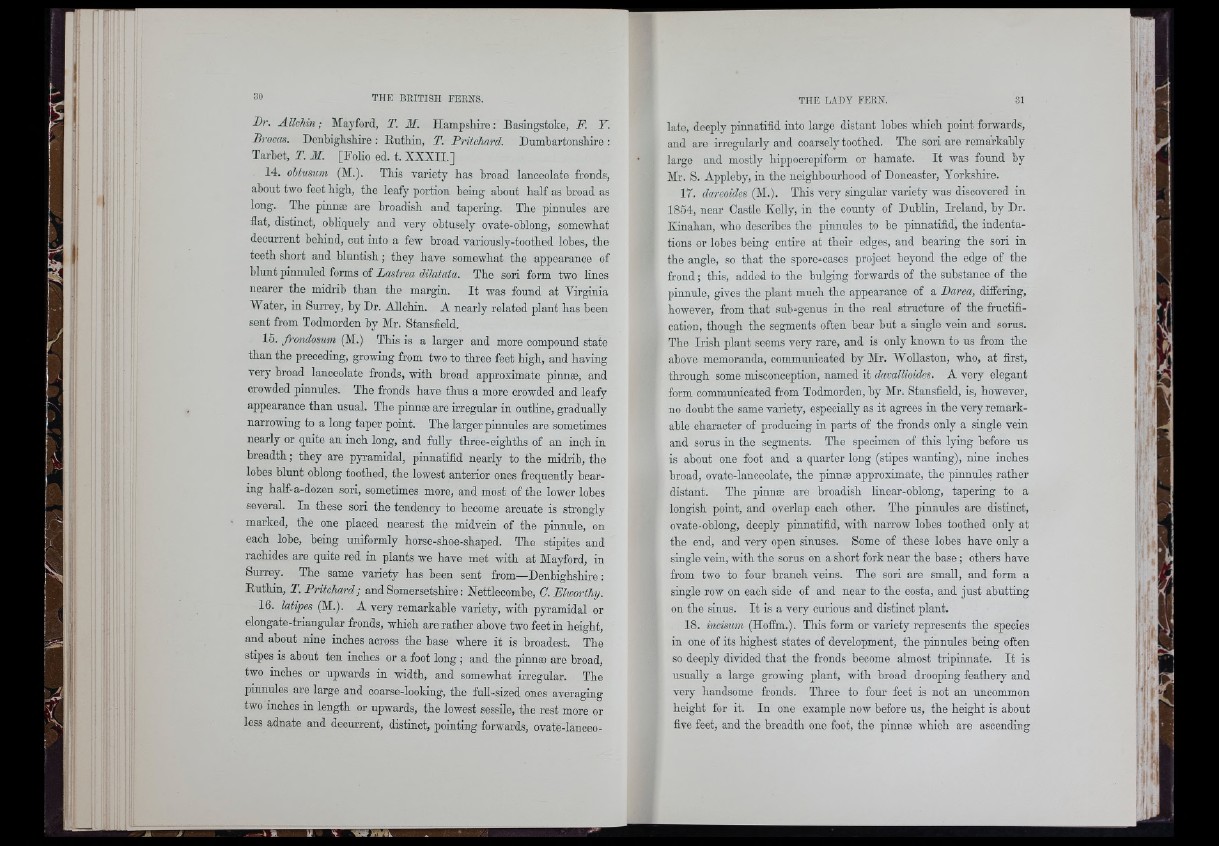
Dr. Allchin ; Mayford, T. M. Hampshire : Basingstoke, F. Y.
Brocas. Denbighshire : Ruthin, T. Pritchard. Dumbartonshire :
Tarbet, T. M. [Folio ed. t. XXXII.]
14. ohtusnm (M.). This variety has broad lanceolate fronds,
about two feet higb, the leafy portion being about half as broad as
long. The pinnæ are broadish and tapering. The pinnules are
flat, distinct, obliquely and very obtusely ovate-oblong, somewhat
decurrent behind, out into a few broad variously-toothed lobes, the
teetb short ana bluntish ; they have somewhat the appearance of
blunt pinnuled forms of Lastrea dilatata. The sori form two lines
nearer the midrib than the margin. It was found at Virginia
TVater, in Surrey, by Dr. Allchin. A nearly related plant has been
sent from Todmorden by Mr. Stansfleld.
15. frondosum (M.) This is a larger and more compound state
than the preceding, growing from two to three feet high, and having
very broad lanceolate fronds, with broad approximate pinnæ, and
crowded pinnules. The fronds have thus a more crowded and leafy
appearance than usual. The pinnæ are irregular in outline, gradually
narrowing to a long taper point. The larger pinnules are sometimes
nearly or quite an inch long, and fully three-eighths of an inch in
breadth ; they are pyramidal, pinnatifid nearly to the midrib, the
lobes blunt oblong toothed, the lowest anterior ones frequently bearing
half-a-dozen sori, sometimes more, and most of the lower lobes
several. In these sori the tendency to become arcuate is strongly
marked, tbe one placed nearest tbe midvein of tbe pinnule, on
each lobe, being uniformly borse-shoe-shaped. The stipites and
rachides are quite red in plants we have met with at Mayford, in
Surrey. The same variety has been sent from—Denbighshire ;
Ruthin, T. Pritchard; and Somersetshire : Nettlecombe, G.Elieorthy.
16. latipes (M.). A very remarkable variety, witb pyramidal or
elongate-triangular fronds, which are rather above two feet in height,
and about nine inches across the base where it is broadest. The
stipes is about ten inches or a foot long ; and the pinnæ are broad,
two inches or upwards in width, and somewhat irregular. The
pinnules are large and ooarse-looking, the full-sized ones averaging
two inches in length or upwards, the lowest sessile, the rest more or
less adnate and decurrent, distmot, pointing forwards, ovate-lanceolate,
deeply pinnatifid into large distant lobes which point forwards,
and are irregularly and coarsely toothed. The sori are remarkably
large and mostly hippoorepiform or hamate. It was found by
Mr. S. Appleby, in the neighbourhood of Doncaster, Yorkshire.
17. dareoides (M.). This very singular variety was discovered in
1854, near Castle Kelly, in the county of Dublin, Ireland, by Dr.
Kinahan, who describes the pinnules to be pinnatifid, the indentations
or lobes being entire at tbeir edges, and bearing tbe sori in
the angle, so that the sporo-oases project beyond the edge of the
frond ; this, added to the bulging forwards of the substance of the
pinnule, gives the plant much the appearance of a Barea, differing,
however, from that .sub-genus in the real structure of the fructification,
though the segments often bear hut a single vein and sorus.
The Irish plant seems very rare, and is only knoivn to us from the
above memoranda, communicated by Mr. Wollaston, who, at first,
through some misconception, named it davalUoides. A very elegant
form communioated from Todmorden, by Mr. Stansfleld, is, however,
no doubt tbe same variety, especially as it agrees in the very remarkable
character of producing in parts of the fronds only a single vein
and sorus in the segments. The specimen of this lying before us
is about one foot and a quarter long (stipes wanting), nine inches
broad, ovate-lanceolate, tbe pinnæ approximate, tbe pinnules rather
distant. The pinnæ are broadish linear-ohlong, tapering to a
longish point, and overlap each other. The pinnules are distinct,
ovate-oblong, deeply pinnatifid, with narrow lobes toothed only at
the end, and very open sinuses. Some of these lobes have only a
single vein, witb the sorus on a short fork near the base ; others have
from two to four branch veins. The sori are small, and form a
single row on each side of and near to the costa, and just abutting
on the sinus. It is a very curious and distinct plant.
18. incisum (Hoffm.). This form or variety represents the species
in one of its highest states of development, the pinnules being often
so deeply divided that the fronds become almost tripinnate. It is
usually a large growing plant, with broad drooping feathery and
very handsome fronds. Three to four feet is not an uncommon
height for it. In one example now before us, the height is about
five feet, and the breadth one foot, the pinnæ which are ascending
I
I A,